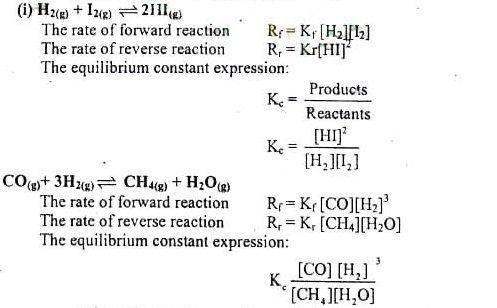Unit 9 – Chemical Equilibrium Short Questions
Q.1 What are irreversible reactions? Give a few characteristics of them?
Q.2 Define chemical equilibrium state.
Q.3 Give the characteristics of reversible reaction.
Q.4 How dynamic equilibrium is established?
Q.5 Why at equilibrium state reaction does not stop?
Q.6 Why equilibrium state is attainable from either way?
Q.7 What is relationship between active mass and rate of reaction?
Q.8 Derive equilibrium constant expression for the synthesis of ammonia from nitrogen and hydrogen
Q.9 Write the equilibrium constant expression for the following reactions:
Q.10 How direction of a reaction can be predicted?.
Q.11 How can you know that a reaction has achieved an equilibrium state?
Q.12 What are the characteristics of a reaction that establishes equilibrium state at once?
Q.13 If reaction quotient Qc of a reaction is more than Kc What will be the direction of the reaction?
Q.14 An industry was established based upon a reversible reaction. It failed to achieve products on commercial level. Can you point out the basic reasons of its failure being a chemist?
Q.1 Differentiate between breathing and cellular respiration.
Answer: The reaction, in which the product do not recombine to form reactants are called irreversible reaction.
Characteristics of Irreversible Reactions
• They are represented by (→) between reactant and product.
• These reactions are proceed to completion.
• These reactions may be conduct in open and close vessels:
• There is no sign of equilibrium state in these reactions.
Q.2 Define chemical equilibrium state.
Answer: When the rate of the forward reaction takes place at the rate of reverse reaction, the composition of the reaction mixture remains constant. It is called a chemical equilibrium state.
![]()
Q.3 Differentiate between breathing and cellular respiration.
Answer:
- They are represented by (⇌ ) between reactant and product.
- It can be attainable from either way. .. A reversible reaction can never go to completion.
- Usually, it can be carried out in a closed vessel.
- In reversible reaction, equilibrium state is the ultimate goal.
Q.4 How dynamic equilibrium is established?
Answer: When reaction does not stop, only the rates of forward reverse reactions become equal to
each other but take place in opposite directions. This is called dynamic equilibrium state
![]()
Q.5 How dynamic equilibrium is established?
Answer: At equilibrium state, a reaction does not stop because forward and reverse reactions keep on taking place at the same rate but in opposite direction. Products recombine to from reactants.
![]()
Q.6 Why equilibrium state is attainable from either way?
Answer: An equilibrium sate is attainable from either way because it may start from reactant to
give products while products recombine to give reactant again.
![]()
Q.7 What is relationship between active mass and rate of reaction?
Answer: Law of mass action describe the relationship between active masses of the reactants and
the rate of a reaction.
According to this law:
The rate at which a substance reacts directly proportional to its active mass and the rate of a reaction directly proportional to the product to the active masses of the reacting substance.
![]()
At equilibrium state:
The rate of forward reaction = The rate of reverse reaction

Law of Mass Action describes the relationship between active masses of the reactants and the rate of a reaction.
Q.8 Derive equilibrium constant expression for the synthesis of ammonia from nitrogen and hydrogen.

Answer:

Q.10 How direction of a reaction can be predicted?.
Answer: Direction of a reaction at particular moment can be predicted by inserting the concentration of reactants and products at that particular amount in the equilibrium expression.

Q.11 How can you know that a reaction has achieved an equilibrium state?
Answer: Dynamic equilibrium
Then reaction does not stop; only the rates of forward and reverse reaction become equal to cach other but take place in opposite directions. This is called dynamic equilibrium state. Dynamic means reaction is still continuing at dynamic equilibrium state.
A reaction get achieved a equilibrium state when the:
Rate of forward reaction = Rate of reverse reaction
Explanation: In a reversible reaction, dynamic equilibrium is established before the completion of reaction. At initial stage the rate of forward reaction is very fast and reverse reaction is taking place at a negligible rate. But gradually slows down and reaction speed up. Eventually, both reactions attain the same rate; it is called a dynamic equilibrium state
Q.12 What are the characteristics of a reaction that establishes equilibrium state at once?
Answer: Characteristics
• In these reaction dynamic state equilibrium are called reversible reaction.
Rate of forward reactions = Rate of reverse reactions
• These reaction does not go to completion.
• These reaction can be proceed in either way.
Q.13 What are the characteristics of a reaction that establishes equilibrium state at once?
Answer: If the value of Qc is more than the Ke. The net reaction goes from right to left or it will move in reverse direction to attain equilibrium.
Q.14 An industry was established based upon a reversible reaction. It failed to achieve products on commercial level. Can you point out the basic reasons of its failure being a chemist?
Answer: In a reversible reaction, the amount of reactants and products remain same when the
equilibrium state achieved, if a industry based on the reversible reaction, it cannot be achieved desired commercial product and its required amount that is why a reversible reaction based industry is failed.

